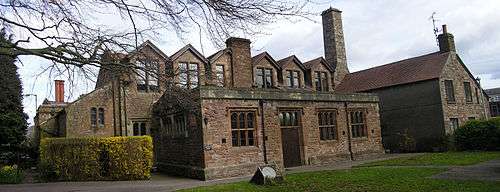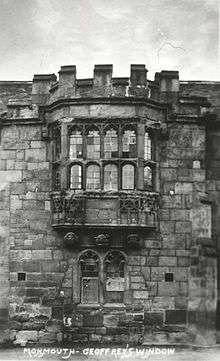Monmouth Priory
| Monmouth Priory | |
|---|---|
 The Priory, showing the oriel window | |
| General information | |
| Type | Benedictine priory |
| Address | Priory Street |
| Town or city | Monmouth |
| Country | Wales |
| Coordinates | 51°48′48.8″N 2°42′50.9″W / 51.813556°N 2.714139°WCoordinates: 51°48′48.8″N 2°42′50.9″W / 51.813556°N 2.714139°W |
| Renovated | 2002 |
| Renovating team | |
| Architect | Keith Murray |
Monmouth Priory, Priory Street, Monmouth, Monmouthshire is a building that incorporates the remains of the monastic buildings attached to St Mary’s Priory Church. The priory was a Benedictine foundation of 1075, and parts of the mediaeval buildings remain.[1] The buildings were substantially redeveloped in the nineteenth century for use as St Mary's National School,[1] and now form a community centre.[2] The complex is a Grade II* listed building as of 27 June 1952.[3] It is one of 24 sites on the Monmouth Heritage Trail.
History
The priory was founded by Withenoc (or Gwethenoc), a Breton who became lord of Monmouth in 1075.[4] There is evidence in the Book of Llandaff of an earlier 8th century Celtic church, and it has been tentatively suggested that this may have been on the site of the later priory.[5] The priory was granted to the Abbey of St Florent at Saumur, and was consecrated in 1101. The priory church was extended and became the parish church later in the twelfth century.[4] The priory was dissolved in 1536.[6]



The monastic buildings were located on the north side of the priory church. Traces of an infirmary were discovered in 1906, when the site of the Baptist Church was being prepared for building. The surviving buildings were the prior's lodgings.[1] The only recognisable surviving medieval feature is the "sumptuous mid-C15 oriel window"[1] which is often erroneously described as having a connection with Geoffrey of Monmouth who lived over three centuries earlier,[7] and which in fact is likely to have formed part of the priory gatehouse.[1] The window contains three corbels in the form of carved heads of high quality, although there is some uncertainly as to exactly what they depict: Newman describing them as representing "an angel between a civilian and what may be a bedesman",[1] whilst Kissack is more empathic in suggesting they portray "a knight, an angel and a miller."[8] The prior's lodgings were extended on several occasions in the nineteenth century, when they were used as St Mary's National School.[1]
The building was restored with the help of funding from the Heritage Lottery Fund. Architect Keith Murray was commissioned to draw up plans for the renovation of the building, which was completed in 2002. It is now available for community use for events such as weddings, conferences and exhibitions.[9]
The Geoffrey Tapestry
In December 2000 it was suggested that a wallhanging might be produced to illustrate the life of Geoffrey of Monmouth. Research, design and preparation took six months and the first stitches were worked in July 2001, at the festivities to celebrate the Priory's 900th anniversary. The work, measuring 1.5 metres (4.9 ft) by 1.6 metres (5.2 ft), was completed in May 2003, after a combined effort by the 14 volunteers of 2,750 hours.[10]
The background design is based on Kempe's ‘The Four Rivers Window’ in St Mary's Priory Church, Monmouth. A Celtic knot pattern gradually rises from green (earth) through blue (sky) to purple (heaven). These intertwining lines were also used by the Hereford School of Romanesque sculptors who were involved with the Priory at the end of the 11th century. A beaded motif from one of the capitals is used in the lower panels of each of the background.
Of the three embroidered "windows", the central panel depicts Geoffrey of Monmouth, modelled on Father James Coutts who instigated the refurbishment of Monmouth Priory. He wears the black habit of the Benedictines. King Arthur with his Queen Guinevere, is being crowned at Caerleon by Dubricius (modelled on the Most Reverend Dr. Rowan Williams, Archbishop of Canterbury and former Bishop of Monmouth). Here the River Usk echoes the river theme of Kempe’s 19th century stained glass window. The Monnow and the Usk link up with the River Wye in the third panel. In this scene King Vortigern listens to the young Merlin telling him the legend of the red and white dragons. Vortigern, initially a lord of Gwent, was, according to legend, eventually killed at Ganarew above the Wye Valley.
Linking the embroidered panels with the background are three circular designs in the lower panels. Beneath Geoffrey is the head of the angel that can be seen outside, sculpted underneath "Geoffrey’s Window". Below Arthur is his shield, "Pridwen", with its image of the Virgin Mary, whilst "Caliburn", his sword, can be seen in the initial ‘A’. Finally, the red and white dragons can be found in the Vortigern panel.[11]
Notes
- 1 2 3 4 5 6 7 John Newman, The Buildings of Wales: Gwent/Monmouthshire, Penguin Books, 2000, ISBN 0-14-071053-1, p.397
- ↑ http://www.cymdeithasgymraegtrefynwy.org.uk/ Monmouth and District Welsh Society (Cymdeithas Gymraeg Trefynwy a'r Cylch); Welsh language website; 20 July 2013
- ↑ http://britishlistedbuildings.co.uk/wa-2323-monmouth-priory-community-centre-monmouth
- 1 2 Glamorgan-Gwent Archaeological Trust Historic Landscape Characterisation: Lower Wye Valley. Accessed 11 January 2012
- ↑ Sarah and John Zaluckyj, The Celtic Christian Sites of the Central and Southern Marches, Logaston Press, 2006, ISBN 1-904396-57-7, p.377
- ↑ Monmouth Group of Parishes: St Mary's Church History
- ↑ PRIORY STREET BOYS' SCHOOL; NATIONAL SCHOOL; OLD PRIORY BUILDINGS, MONMOUTH, Royal Commission on the Ancient and Historical Monuments of Wales
- ↑ Kissack, K. The Lordship, Parish and Borough of Monmouth, page 13
- ↑ About Monmouth Priory
- ↑ Sticthes and Stories- the Geoffrey Wall Hanging and How it Came to Be", colour booklet, published by Monmouth Priory, 2005.
- ↑ "Legacies - South East Wakes: Local Legends" at bbc.co.uk
References
- Newman J., The Buildings of Wales: Gwent/Monmouthshire, (2000) Penguin Books
- Kissack, K., The Lordship, Parish and Borough of Monmouth, (1996) Lapridge Publications